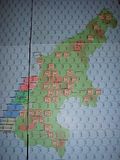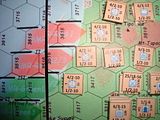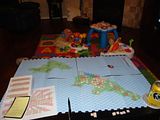PIC-Saipan/Tinian Game Review Part I
Chris sent me a review copy of Pacific Islands Campaign - Saipan/Tinian at the end of April. I finally found some time to review it this week. (After the release date...sorry, Chris!)
The maps are beautifully executed and easy to read. The counters are good: the die cuts are crisp and well registered, and the counters punch easily with no separation. All the charts are well laid out and easy to use. There were a few minor typos in the rules book but, as I said, this was a preliminary copy. I pointed out all the issues I could find to Chris, and I'm certain the production copies have the necessary corrections.
I setup the Japanese counters on Saipan. This is a useful and necessary step for the Japanese player. Necessary, because you can't play the game without first setting up the counters. Useful, because it gives the player an idea of what can and can't be done.

The "center of gravity" of the Japanese units on the island is in the geographic center of the island, and near the northern beaches. The rules prohibit free setup of units except for three companies of naval troops, and only three fortifications may be placed on beach hexes, though a total of 18 fortifications may be placed on the entire island.

Based on these limits, I would recommend a strategy similar to the de facto historical one. Similar, but not quite the same. Historically the Japanese fell back to the north and defended stubbornly. I recommend the same approach, but suggest it be done systematically. Place the three naval companies and the three permitted fort counters on the northernmost beach hexes. This is a forlorn hope as the odds are against those units surviving the amphibious assault phase, and the southern surviving unit will almost certainly be annihilated during the remainder of the turn. Still, these units will buy time. All units north of the lines of fortification counters head south, except perhaps for some engineering companies as described below. These units will be needed in the south early on anyway, so move all that are not needed to prepare fall back positions.

Carpet the hexes from 3717 southeast to 3219, forming a line across the island. Do the same thing from 3817 to 3320. Place the last three forts on 3420, 3521, and 3620. Have all units south of that line fall back towards that line. Sacrifice a few units if needed to slow down the US advance. Have any engineering units in fortification hexes upgrade those fortifications the first turn. (Remember 3420, 3521, and 3620?) Engineering units will continue to pave the north half of the island with forts. Once arriving at the first east-west line of fortifications the US units should have to struggle against fortifications all the way to Marpi point.
Once the Japanese have consolidated to the north, always fight in the best terrain and under forts. Attrition is the key. Always keep six steps of units in each hex on the FEBA to ensure the hex will not be overrun. As long as you can feed units into the line, the US cannot advance. Try to channel the US units into clear hexes where possible to maximize casualties.
Don't place artillery in clear hexes in order to avoid counterbattery fire.
Consider falling back occasionally in order to provide subsequent opportunities for Defensive First Fire. Also fall back to shorten lines as casualties mount and to skip over clear terrain that does not favor the defense.
Always cause casualties. The odds are extremely against the Japanese player achieving the time limit victory conditions. Most likely, the US will be knocking on the door right around the timing in the historical schedule. The best the Japanese side can hope for is to cause enough US casualties to reduce the victory level, and perhaps cause enough caution in the US player to have a better chance of delaying past the historical outcome.
The final bit of advice I can give the Japanese player is to use Banzai attacks frequently and prudently. There is no US Defensive First Fire at night, so you can safely mass and shift units. The 3x attack factors multiple and the +3 die roll modifier for Banzai attacks allow you to attack stronger units or stacks with weaker units and still cause casualties. Consider having an engineer platoon with artillery support Banzai charge a lone infantry company in clear terrain. The odds will be about 1-2, and the net DR should be +4. This gives a 2/3 chance of eliminating a company with a platoon.
Next I will compare company counts, average attack/defense factors, and total steps for the Japanese and US forces. I will also setup the units on Tinian and write up some notes on that part of the battle. It may be some time before I complete this...check out my "command central" for working on these notes, especially the background.

Labels: Beta, game, GSI, PIC-Saipan/Tinian, review, Saipan







 RSS Feed
RSS Feed
